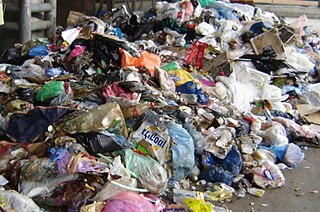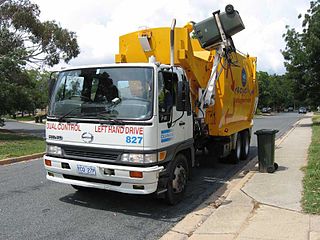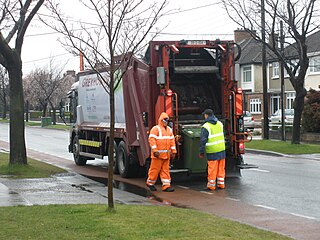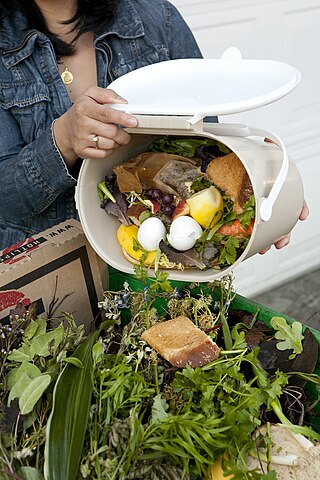This article has multiple issues. Please help improve it or discuss these issues on the talk page . (Learn how and when to remove these template messages)
|
Statistical data shows that waste management in Winnipeg during the COVID-19 Pandemic.
This article has multiple issues. Please help improve it or discuss these issues on the talk page . (Learn how and when to remove these template messages)
|
Statistical data shows that waste management in Winnipeg during the COVID-19 Pandemic.
The statistical data show that with the increase in the GDP per capita of Winnipeg, waste generation decreased due to the increased effectiveness of the municipal waste management plan after 2005. The city of Winnipeg has implemented various strategies to address municipal waste treatment. [1]
On October 19, 2011, the Winnipeg City Council approved the master plan of a comprehensive waste management plan, requested by the City Council to the Public Service on June 23, 2010, for the entire city to increase the waste diversion rate to 50% or more. This plan would achieve this target by reducing household garbage and by increasing household recycling. This plan was made effective for municipal waste management by Winnipeg in the first week of October 2012.
The Comprehensive Waste Management Plan is based on three main guiding principles which were established through the Phase – 1 participation process and input from the Stakeholder Advisory Committee. These principles help to shape the goals and objectives of the Garbage and Recycling Master Plan (GRMP) that helps to guide potential options for the garbage, recycling, and organic services in Winnipeg. Those Principles are:

The municipal waste management by Winnipeg City is consistent with the Provincial regulations. A curbside collection of recyclables to the residential locations is provided by the City of Winnipeg. Figure – 5 shows the residential recycling reports that show that recycling at the residential level in Winnipeg has an 85% of participation rate, which results in diverting approximately 48,087 tonnes of recyclable materials from the waste landfill disposal stream. This tonnage is equivalent to approximately 17% of the waste stream. Recyclables that are collected by the City of Winnipeg from the residential locations include a standard list of blue box material that includes:
Some other programs have been undertaken by the City of Winnipeg other than recycling for Waste minimization and diversion. These programs include Leaf-It Depots, Chin-In Depots, and a Backyard Composting program. Winnipeg also has seven general-use recycling depots around the city. The net cost of the current recycling program depends on the market rates for the recycled materials and the level of funding received under Provincial regulation. Over the past 15 years, Winnipeg City has recycled more than 700 million kg of waste through the Manitoba Product Stewardship Corporation (MPSC), which pays 80% of the net cost of the recycling service.
The reduction of waste at or near the source of generation is known as Source Reduction of waste and this is one of the most important and promising methods for reduction in the waste generation for the growing waste in Canada. [4] The Source Separated Organics (SSO) also counts under the treatments of municipal waste and source reduction techniques. This treatment helps in minimizing the waste in other words SSO is used for diverting solid wastes from the landfills. These SSO have comprised about 1/ 3 to 1⁄2 of the total residential waste of Winnipeg. SSO includes materials like kitchen waste, yard waste, etc. and Winnipeg did about 53% of the total (kitchen + yard waste) of composting that includes 24% of Kitchen waste and 68% of Yard waste. [5] This SSO is separated from the undesirable materials that are then sent to the curbside collection as a separate residual waste stream.
The City of Winnipeg is evaluating new technologies and processes for resource recovery, such as thermal oxidation, carbonizing, aerobic digestion, pelletizing, and organic waste management. The decomposition of organic waste releases methane gas, and landfills consisting of organic waste generate methane gas, known for its harmful effects on the environment as a greenhouse gas (GHG). National statistics indicate that 4% of the total GHG emissions are generated from landfills. The City of Winnipeg may at some point use this gas as a resource recovery opportunity at the Brady Landfill site to displace natural gas or to produce electricity. Currently the gas is being collected via in-ground perforated pipe under negative pressure and flared. Talks between the city, Manitoba Hydro and the University of Manitoba about supplying this gas to the campus (approx.. 6 km away) has not led to any action to date. Alternatively, the gas could be added to the grid once it was scrubbed to remove H2S, CO2, and water.
The City of Winnipeg currently composts yard wastes during summer months and has initiated a pilot curbside pick-up of kitchen organics for approximately 4000 residences. This project will be assessed in 2023.
The statistics shown in table below is the data representation of waste generation and economic development of Winnipeg City, and shows the municipal Waste Generation, Population and real GDP of the city. Here real GDP is used as an economic growth indicator of the city.
| Sr. No. | Year | Population | Real GDP (million $) | Total MW (tons) | MW (kg/capita/year) |
|---|---|---|---|---|---|
| 1 | 1997 | 618477 | 19340 | 225149 | 330.24 |
| 2 | 2001 | 619544 | 21517 | 254334 | 372.41 |
| 3 | 2006 | 633451 | 24035 | 274355 | 392.91 |
| 4 | 2011 | 663617 | 26463 | 255576 | 349.37 |
In 1997, the population of Winnipeg was approximately 618,477 whereas the real GDP of the city was approximately $19,340 million. At the same time, the waste generation of the city was 225,149 tons/yr, with an average of 330.24 kg/per capita/yr. In 2001, the population was 619,544, real GDP was $21,517 million, and the waste generation in the city was 254,334 tons/yr, with an average of 372.41 kg/per capita/yr.
According to table-1 faced maximum waste generation in the year 2006, with a population of 633,451, real GDP of $24,035 million, and a waste generation of 274,355 tons/yr. with an average of 392.91 kg/per capita/yr. This data shows that the City of Winnipeg was facing the challenge of an increasing population, increasing GDP, and, at the same time, an increase in waste generation of Winnipeg.
After realizing the challenge, the City of Winnipeg increased its Waste Management efficiency and the results are represented in table-1 and figure-1. In the year 2011, the City of Winnipeg was able to reduce the waste generation of the city, despite the growing population.

Waste management or waste disposal includes the processes and actions required to manage waste from its inception to its final disposal. This includes the collection, transport, treatment, and disposal of waste, together with monitoring and regulation of the waste management process and waste-related laws, technologies, and economic mechanisms.

A landfill is a site for the disposal of waste materials. It is the oldest and most common form of waste disposal, although the systematic burial of waste with daily, intermediate and final covers only began in the 1940s. In the past, waste was simply left in piles or thrown into pits.

Municipal solid waste (MSW), commonly known as trash or garbage in the United States and rubbish in Britain, is a waste type consisting of everyday items that are discarded by the public. "Garbage" can also refer specifically to food waste, as in a garbage disposal; the two are sometimes collected separately. In the European Union, the semantic definition is 'mixed municipal waste,' given waste code 20 03 01 in the European Waste Catalog. Although the waste may originate from a number of sources that has nothing to do with a municipality, the traditional role of municipalities in collecting and managing these kinds of waste have produced the particular etymology 'municipal.'
Pay as you throw (PAYT) is a usage-pricing model for disposing of municipal solid waste. Users are charged a rate based on how much waste they present for collection to the municipality or local authority.
The Solid Waste Authority of Central Ohio (SWACO) was established by the Ohio General Assembly in 1989 as part of Ohio House Bill 592, which created Ohio’s current solid waste management planning and regulatory programs. SWACO is a government-run entity responsible for the safe and sanitary management of all solid waste within its district. In this role, it operates the Franklin County Sanitary Landfill, as well as two transfer facilities, all for the benefit of Franklin County, Ohio, and parts of surrounding counties in central Ohio.

Kerbside collection or curbside collection is a service provided to households, typically in urban and suburban areas, of collecting and disposing of household waste and recyclables. It is usually accomplished by personnel using specially built vehicles to pick up household waste in containers that are acceptable to, or prescribed by, the municipality and are placed on the kerb.

Green waste, also known as "biological waste", is any organic waste that can be composted. It is most usually composed of refuse from gardens such as grass clippings or leaves, and domestic or industrial kitchen wastes. Green waste does not include things such as dried leaves, pine straw, or hay. Such materials are rich in carbon and considered "brown wastes," while green wastes contain high concentrations of nitrogen. Green waste can be used to increase the efficiency of many composting operations and can be added to soil to sustain local nutrient cycling.

Biodegradable waste includes any organic matter in waste which can be broken down into carbon dioxide, water, methane, compost, humus, and simple organic molecules by micro-organisms and other living things by composting, aerobic digestion, anaerobic digestion or similar processes. It mainly includes kitchen waste, ash, soil, dung and other plant matter. In waste management, it also includes some inorganic materials which can be decomposed by bacteria. Such materials include gypsum and its products such as plasterboard and other simple sulfates which can be decomposed by sulfate reducing bacteria to yield hydrogen sulfide in anaerobic land-fill conditions.

A green bin is a large, movable, rigid plastic or metal container that contains biodegradable waste or compostable materials as a means to divert waste from landfills. In some local authorities, green bins are also used to contain unsorted municipal solid waste.

This article outlines the position and trends of recycling in Canada. Since the 1980s, most mid to large municipalities in most provinces have recycling programs, relying on curbside collection with either bins, boxes, or bags. These systems are not standardized, and the specific process differs for each province. Certain provinces have container-deposit systems in place for bottles, cans, and other beverage containers.

The blue box recycling system (BBRS) was initially a waste management system used by Canadian municipalities to collect source separated household waste materials for the purpose of recycling. The first full-scale community wide BBRS was implemented in 1983 by the waste management contractor Ontario Total Recycling Systems Ltd. for the City of Kitchener, Ontario. The blue box recycling system was implemented as part of the city's waste management procedures. The blue box system and variations of it remain in place in hundreds of cities around the world.
The California Department of Resources Recycling and Recovery is a branch of the California Environmental Protection Agency that oversees the state's waste management, recycling, and waste reduction programs. CalRecycle was established in 2010 to replace the California Integrated Waste Management Board. It is known for administering the California Redemption Value (CRV) program, among other responsibilities.
Waste management in Japan today emphasizes not just the efficient and sanitary collection of waste, but also reduction in waste produced and recycling of waste when possible. This has been influenced by its history, particularly periods of significant economic expansion, as well as its geography as a mountainous country with limited space for landfills. Important forms of waste disposal include incineration, recycling and, to a smaller extent, landfills and land reclamation. Although Japan has made progress since the 1990s in reducing waste produced and encouraging recycling, there is still further progress to be made in reducing reliance on incinerators and the garbage sent to landfills. Challenges also exist in the processing of electronic waste and debris left after natural disasters.

Recology, formerly known as Norcal Waste Systems, is a waste management company headquartered in San Francisco, California. The company collects and processes municipal solid waste, reclaiming reusable materials. The company also operates transfer stations, materials recovery facilities (MRFs), a number of landfills, and continues to spearhead renewable energy projects. Recology is the largest organics compost facility operator by volume in the United States.
Waste, unwanted or unusable material, varies in type and quantity in different countries.

Source-separated organics (SSO) is the system by which waste generators segregate compostable materials from other waste streams at the source for separate collection.
Game day recycling is the idea that having large crowds of people in a small, concentrated space will generate a great deal of refuse and products that require recycling. A home football game at a college with a high-capacity stadium can attract up to 110,000 people. However, because colleges only play a limited number of games at home throughout each season, the game-day recycling programs are usually specialized and separated from the school’s regular recycling program.
The City of Oakland, California, adopted a Zero Waste Strategic Plan in 2006, detailing a road map for the city to follow toward the implementation of a Zero Waste System by 2020. As stated in a City Resolution, introduced by then Mayor Jerry Brown, Zero Waste principles:
The San Francisco Mandatory Recycling and Composting Ordinance is a local municipal ordinance requiring all persons located in San Francisco to separate their recyclables, compostables and landfilled trash and to participate in recycling and composting programs. Passed by the San Francisco Board of Supervisors in 2009, it became the first local municipal ordinance in the United States to universally require source separation of all organic material, including food residuals.

New York City's waste management system is a refuse removal system primarily run by the New York City Department of Sanitation (DSNY). The department maintains the waste collection infrastructure and hires public and private contractors who remove the city's waste. For the city's population of more than eight million, The DSNY collects approximately eleven thousand tons a day of garbage, including compostable material and recycling.